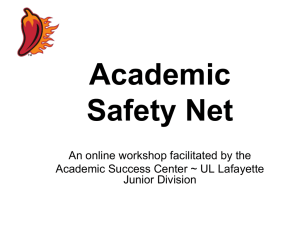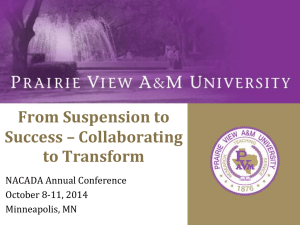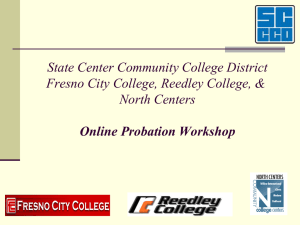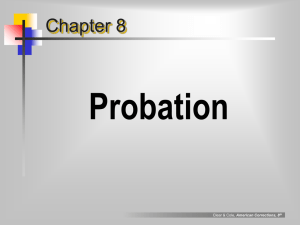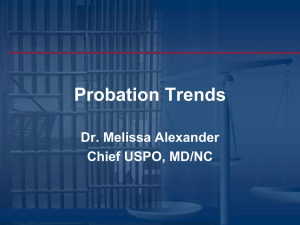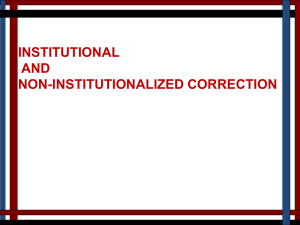academic probation - Kansas State University
advertisement
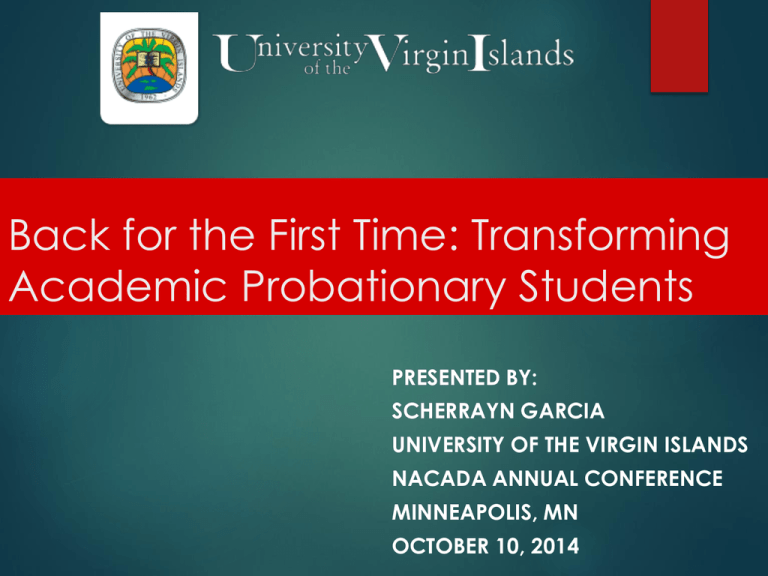
Back for the First Time: Transforming Academic Probationary Students PRESENTED BY: SCHERRAYN GARCIA UNIVERSITY OF THE VIRGIN ISLANDS NACADA ANNUAL CONFERENCE MINNEAPOLIS, MN OCTOBER 10, 2014 Fast Facts: Public 4-year institution Historically Black Colleges and Universities (HBCU) 2 Campuses separated by 40 miles of water Total Population is 2,500 students 95% Minority 812 - Average SAT score (Math and English Combined) for incoming freshmen (2013) 97% Admit Rate The only post-secondary institution within the US Virgin Islands’ territory. WHY NOT? Academic Probation Rates Introduction Many postsecondary institutions are investing millions of dollars in student support services to ensure students improve their academic performances and attain their postsecondary degrees; yet the rate at which students are placed on academic probation remains alarming. While the intent of establishing an “academic probation” policy is to promote student success, increase retention and graduation rates; academic probation often times deter students from returning to their respective institutions. Unintended Outcomes of Academic Probation Policy Academic probation status reduces the chances that some students return to school for their second year, although most complete their first year (Fletcher, J.M. and Tokmouline, M., 2010). Lindo, J. Nicholas S., and Phillip, O. (2010) found that when students are placed on academic probation it doubles the probability “that male students will leave school and doubles the probability that students who performed better in high school will also leave school” (p.112). Academic Probation’s Effect on Graduation Rates A probation analysis report was conducted at the LaGuardia Community College by Jeffery Weintraub in 2012. He analyzed the persistence and graduation rates of over 6,000 students and found that 9.1 % of students placed on probation graduated as compared to 26.6% of non-probation students. 30 20 10 0 Probation Students Non-Probation Students Academic Probation’s Effect on Retention Rates Nearly 25% of all college students will be on academic probation at some point in their college careers and roughly 50% of these probationary students will voluntarily drop out (Damashek, 2003) What does this means in financial loss for institutions nationally? Economic Consequence of Academic Probation 11,097,77 9 FT Student Enrolled (2012) $19,339 (2012) Average Cost Tuition, Room, & Board $19,339 2,774,444 25% Academic Probation X 1,387,222 50% Drops out $26,827,486,258 Financial Loss Number of students enrolled is reflective of full-time undergraduate students at private and public institutions. Full-time student enrollment and average cost were based on the 2011-2012 data provided by the National Center for Educational Statistics. What is Academic Probation? Academic probation is primarily a system that is intended to warn students who are enrolled (part-time or full-time) at any given university to improve their academic standing in order to remain at the university. If a student does not meet Satisfactory Academic Progress (SAP) he or she will be placed on academic probation. University of the Virgin Islands’ (UVI) Satisfactory Academic Progress (SAP) Total Credits Attempted Percent Rate For Minimum Credits Passed Minimum Cumulative and/or Semester GPA 12-29 50% 1.70 30-44 60% 1.80 45 and above 70% 2.00 UVI Academic Probation Progression Stages Probation I/ Warning Probation II Suspension • Cause: 1st Occurrence where a student did not meet the SAP • Max credit load is reduced and student can not participate in extracurricular activiites. • Cause: 2nd occurrence where student did not meet the SAP • Max credit load is reduced to p/t and student can not participate in extracurricular activiites. • Cause: 3rd occurrence where student did not meet the SAP • Student is suspended for one semester. Academic Probation Progression Probation I/ Warning Probation II Suspension Financial Aid Probation Progression Probation Suspension (NO Aid) Response to Academic Probation When students are on probation they are met with strict standards that mandate they must meet SAP or be subjected to the loss of financial aid and suspension from the university. At this time the students are given three options: 1. Enroll the following semester improve their GPA and possibly get off probation. 2. Enroll the following semester fail, and risk the loss of financial aid and being placed on academic suspension 3. Do not return return the following semester. Theoretical Explanation for Probationary Students Responses The decision to voluntarily drop out of college can be best explained by the Benabou and Tirole’s (2000) model of agents’ responses to performance standards. The model explains that when an agent is met with performance standards he or she has three options. In the case of students who are on probation: • If the agent (student) attempts option (1) he incurs cost and high benefit; • If he attempts option (2) he will then incur cost and gain no benefit; • If he attempts option (3) he will not incur cost and will not gain any benefit. This then becomes discouraging to students. Some students opt for option 3 and decide not to risk further cost (emotional, psycological, and/or economical) to their circumstance. Lindo, J. Nicholas S., and Phillip, O. (2010) Compounded Challenges of Probationary Students Benabou and Tirole’s (2000) model of agent response to a performance standards also states that the agents (students) who choose option 1 (remain at the institution), are motivated to meet the performance standards and increase their academic performances (Lindo et al. 2010). However these students are met with myriad of issues that are compounded which weighs heavily on their efforts during their probationary period. Issak, Graves, and Mayers (2006) found that students on academic probation identified more areas of difficulty than did students not on probation. As challenges compound, they may have an increasing negative impact on a student‘s academic success. Consequences Probationary Students Experience Emotional Shame Hurt Embarrassment Psychological Academic Decreased Academic Confidence Loss of Opportunities Loss of Financial Aid Anger Reduction in Self-Esteem Frustration Depression Delayed Graduation Anxiety Drop out Now that I am on academic probation and have lost my financial aid, is there any hope for my overall success? Let’s hear directly from one student. (The student within the video granted the presenter permission to include video in presentation for NACADA members viewing only. Please do not download the video.) Working with Students on Probation who have lost their Financial Aid 1) What are some strategies you or your institution have implemented in an effort to ensure students who are placed on academic probation/suspension return to the institution the subsequent semester? 2) What strategies have you or your institution developed to assist students who were placed on probation and/or lost their financial aid? 3) What strategies would you propose are the most effective in working with students on academic probation? Academic Recovery Strategies • Assist students in creating a written plan of action to get off probation and regain their financial aid. • Be sure to provide consistent and frequent follow-up. • Provide a “wrap-around” approach of service delivery for students who are on suspension and have garnered an approval of appeal via the suspension committee. • Fail Grade Forgiveness Policy: Students who fail their courses and have repeated them will have their transcript wiped clean of the initial grade of “F”. Students must obtain a “C” or higher in their subsequent attempt of the courses they fail. See page 3 of Jefferey Weintraub “Analysis of Students Placed on Probation” report at www.lagcc.cuny.edu Please contact LaGuardia Community College for more information on the use and implementation of this policy.* • Establish funding (special grant) for students who are on probation, who have lost their financial aid and have demonstrated academic improvement. Institutional Next Steps Investigate the dynamics of academic probation on your student population. • What are the academic probation rates for your institution? • Which student is more likely to be on probation or suspension? Develop a profile. • What are the factors that contribute to poor academic success? • What are the trends that occur within the dynamics of academic probation? • What can your institution do to reduce our probation rates and prevent the occurrence of students being placed on academic probation? •Are these strategies, programs, and services working? References Benabou, R. and Tirole, J. (2000). “Self-Confidence and Social Interactions.” National Bureau of Economic Research Working Paper 7585 Damashek R. (2003). “Support programs for students on academic probation.” Department of Education Reports, Descriptive. 2003;141:18. Fletcher, J.M. and Tokmouline, M. (2010). “The Effects of Academic Probation on College Success: Lending Students a Hand or Kicking Them While They Are Down?” THEOP Working Paper Giner, S. and Kelly-Reid (2013). Enrollment in Postsecondary Institutions, Fall 2012; Financial Statistics, Fiscal Year 2012; Graduation Rates, Selected Cohorts, 2004-09; and Employees in Postsecondary Institutions, Fall 2012: NCES Department of Education Isaak, M. I., Graves, K. M., & Mayers, B. O. (2006-2007). Academic, motivational, and emotional problems identified by college students in academic jeopardy. J. Coll. Stu. Retention, 8, 171-183. References Lindo, J. Nicholas S., and Phillip, O. (2010). Ability, Gebder, and Performance Standards: Evidence from Academic Probation American Economic Journal: Applied Economics 2(2) National Center for Educational Statistics 2011-2012. http://nces.ed.gov/fastfacts/display.asp?id=76 Scherrayn Garcia, MSW sphilli1@uvi.edu 340-692-4274 Thank you for your Participation!!!!



